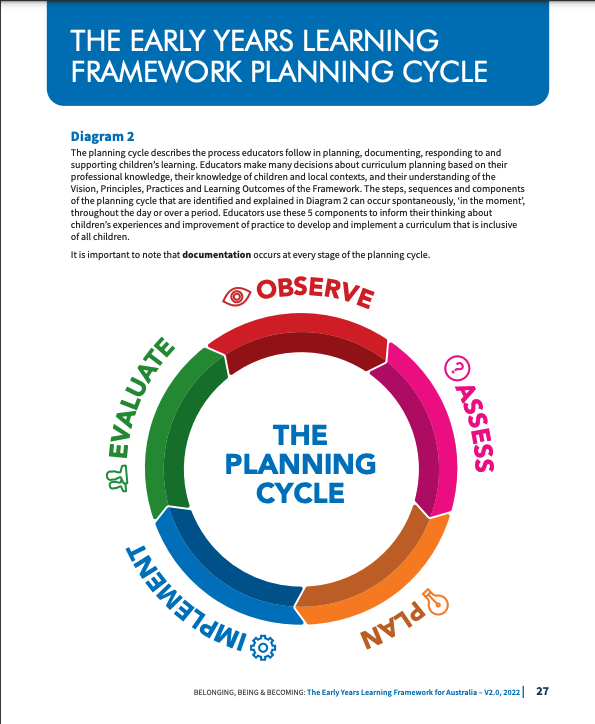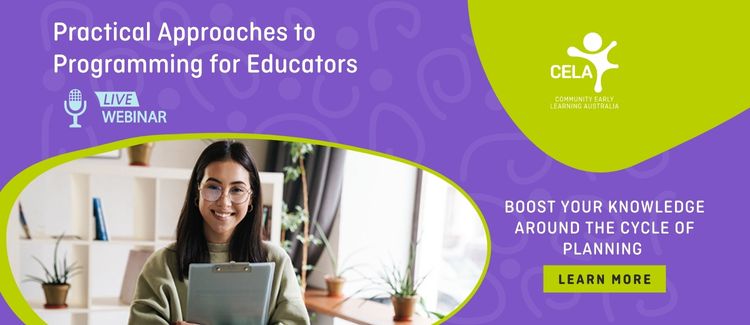Establishing how you plan and program as an educator can be challenging to begin with. Most teachers will tell you that their planning is inherently linked with their teaching philosophy; Reggio Emilia-inspired teachers will lean toward inquiry-based teaching and learning, while Montessori-inspired teachers will emphasise the importance of structured skills-based learning, but most teachers establish their own integrated approach of facilitation, shared exploration and a balance between child and adult-led learning.
There’s no simple way to establish your method. It comes with experience, trials and pivots in your journey as a teacher. Many teachers will testify that their planning often changes to cater to the differing needs of each class group, with some needing more structure and support to extend their learning than others.
So, where to start?
Extend on interests and ask the children via interest-led learning and teaching
One of the easiest ways to gain enthusiasm and engagement from a group is to extend their learning in areas of interest. There are some key interest areas that emerge year after year such as dinosaurs, “being the teacher” pretend play or painting rainbows. Of course, the simplest way to gain insight into children’s current interests is simply to ask the children themselves. You can leave activity areas empty and ask groups of children as they enter about what they may enjoy that day.
However, when attempting to establish class-group interests, consider the following:
-
Which areas of the classroom were busiest last week? (home corner, construction area, puzzle shelf, etc.)
-
Which activity or resource are the families telling you their child talked about at home?
-
Have the children repeatedly asked for a resource or activity that is no longer visible in the classroom?
Consider ways to embed learning about essential skills
It can be easy to fall into the trap of thinking that each individual activity or resource must fit neatly into the box of being “interest-led”; however, that is not always possible. While interest-led planning is a wonderful way to represent the child’s voice in your classroom and gain sustained engagement, this is only one component of the complex landscape that is planning for preschool-aged children.
As a teacher, much of my intentional teaching is around scaffolding the essential skills children develop in the early years. Because of that, I’ll often integrate learning around something that may be challenging my students. This could be around kindness, building friendships, or speaking up for yourself when being challenged by other children. Rarely do these topics arise from children as a key interest. However, these topics are just as valuable in my teaching, so I embed them in my curriculum through structured learning times and by using specific language in my interactions with children.
The value of intentional teaching
A common misconception, particularly among people new to the early learning sector, is that planning and programming is focused on teaching content such as days of the week, dinosaur names, and butterfly life cycles. The language used by the approved learning frameworks and the National Quality Standards highlights the significance of intentionality in our teaching; however, instead of viewing this as structured lessons (where we try and get young children to remember the names of all the dinosaurs), we must view intentionality as the strategies which we put into place every day to support children within the program.
For example, reminding a child who’s still developing the skills of self-regulation to take a deep breath, asking a child if they can remember the name of the author of the book you’re reading or inviting a group of children to tidy up a play area can all be examples of intentional teaching. These strategies are an inherent part of our programs, and can all easily be linked to different elements of the EYLF. These links should be reflected in your planning! Whether it’s a written reflection of the week that’s been, or the program for the fortnight—find an outcome of the EYLF which supports your intentional practice. You’ll be surprised how many are relevant to the small, but intentional, parts of our practice.
The planning cycle and the updated EYLF 2.0
The recently updated Early Years Learning Framework (EYLF) Version 2.0 includes more depth around the planning cycle than we’ve previously seen in any guiding documents. Though it was previously outlined in the Educator’s Guide to the Early Years Learning Framework (EGEYLF), there has been a large shift in both the language used and the depth of detail. Previously referenced as “Reflect/Review, Question, Plan, Act/Do”, the new version of the EYLF offers a slightly more prescriptive approach, aligning itself more with the common language used by professionals working in the classroom. Now referred to as “observe, assess, plan, implement and evaluate”, the planning cycle is more clearly a documented trail of each child’s progress and development.

Source: ACECQA, BELONGING, BEING & BECOMING: The Early Years Learning Framework for Australia – V2.0, 2022 pg. 27
Crucially, each step of the new planning cycle is outlined in detail, offering instruction and context for each step.
For example, under step one (Observe), the EYLF notes that observation of children is taken at various times throughout the child’s contact with the service, so that "educators acknowledge, document and describe children’s capabilities and unique ways of belonging, being and becoming ensuring children’s and families’ voices are sought, heard and included.” (ACECQA, 2022)
Beyond these significant changes is the outlining of the three differing forms of assessment; formative, summative and “assessment for learning”. This terminology is likely new to many educators (and not just those new to the sector) as it is more formal language than we’ve seen offered in guiding documents in the past. Though it may seem daunting at first, after reading the outlining of these forms of assessment, it will become clear that the observations we engage with each day fit easily within these categories. It's also important to note that this move towards language commonly used throughout the rest of the education sector is a positive step towards aligning our work with that of primary and high school professionals.
It can be easy to get lost in the step-by-step breakdown of the cycle, and many services will respond to this update by quickly creating or adjusting templates to ensure everything is covered. Make sure that before these changes are implemented, you have the opportunity to explore and reflect on the cycle and how it can be put into place in a way which aligns with service philosophy, educator ability and time allocated to fulfil these requirements.
7 top tips for educators that are new to planning and programming:
-
Balance child-led and adult-led activities and interactions: your input as an educator is also important.
-
Remember, intentional teaching is about much more than simply giving subject-based content. Use intentionality in your management of behaviours, your routines, and your interactions with children.
-
Be strength-based, but also be aware of the challenges arising in your classroom. These can be integrated into your program and your teaching.
-
Group times can be as short or as long as you want them to be. Avoid lengthy, disengaging group times where children with short attention spans are expected to sit and listen.
-
If something isn’t working, change it. The best teachers I know tweak their planning and programming to suit both their own needs and the group's needs.
-
Don’t run a weekly program. Instead, start with a month-to-month program, where you allow yourself to make changes where needed. Weekly or fortnightly programs will result in you drowning in paperwork.
-
Ask for input. Discuss your thoughts with your colleagues, post in Facebook groups and attend professional development webinars. Gain insight into as many differing ideas, resources, templates and perspectives as possible—the more you learn, the more you’ll be able to establish your own format and strategies.
Further reading:
ACECQA BELONGING, BEING & BECOMING: The Early Years Learning Framework for Australia – V2.0
Amplify! Tips for communicating respectfully with children, by Meg Anastasi
Amplify! How we can scaffold children’s learning by allowing for ‘aha’ moments by CELA
Amplify! The role of guided play in early education and care by CELA
CELA professional development relating to this topic

FIND OUT MORE
About Meg
Meg is an Early Childhood Teacher in the eastern suburbs of Melbourne on Wurundjeri land. She has worked across a range of settings throughout her decade of work in the early learning sector, and is now pursuing postgraduate study in adult education. Meg is very passionate about advocating for the early childhood profession in a way that both challenges and empowers educators.